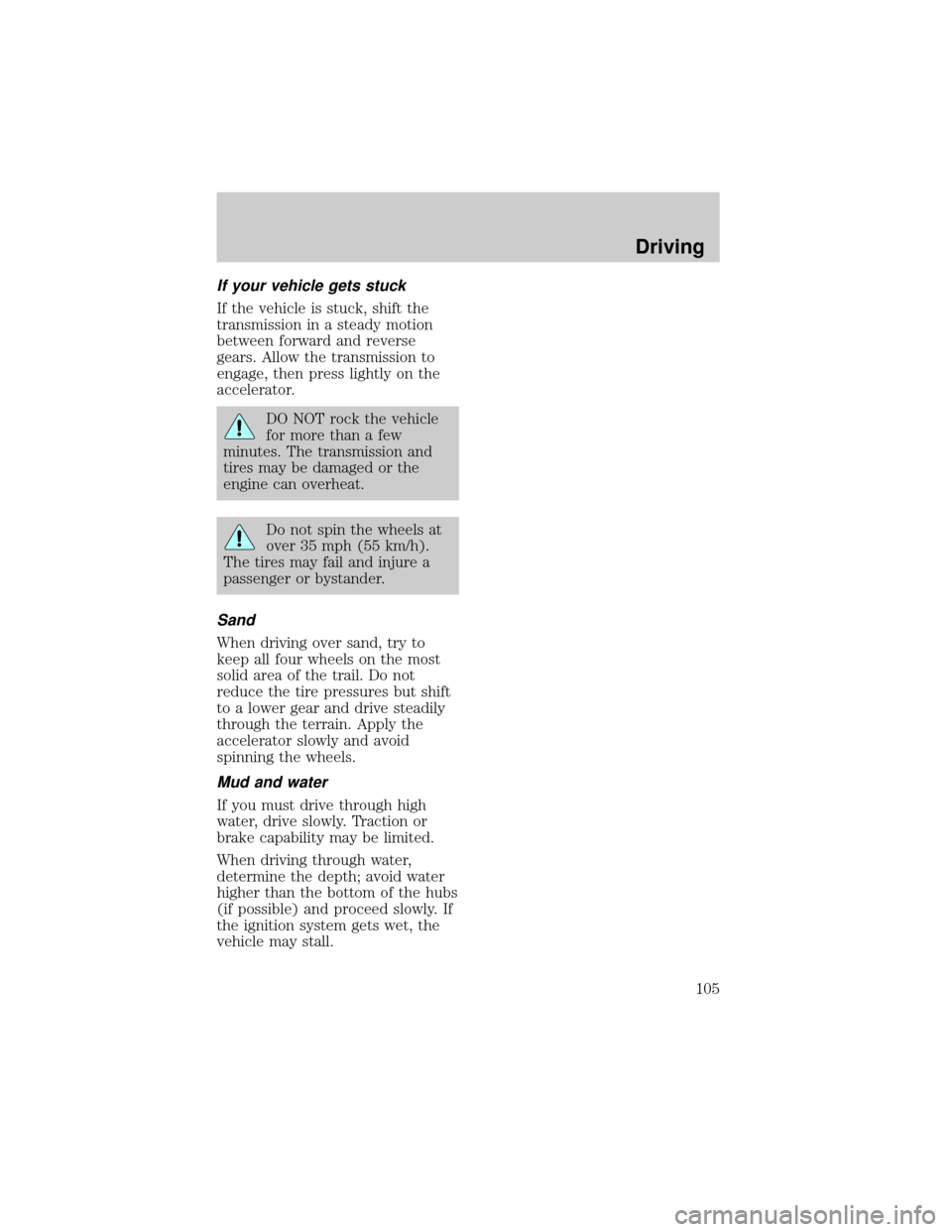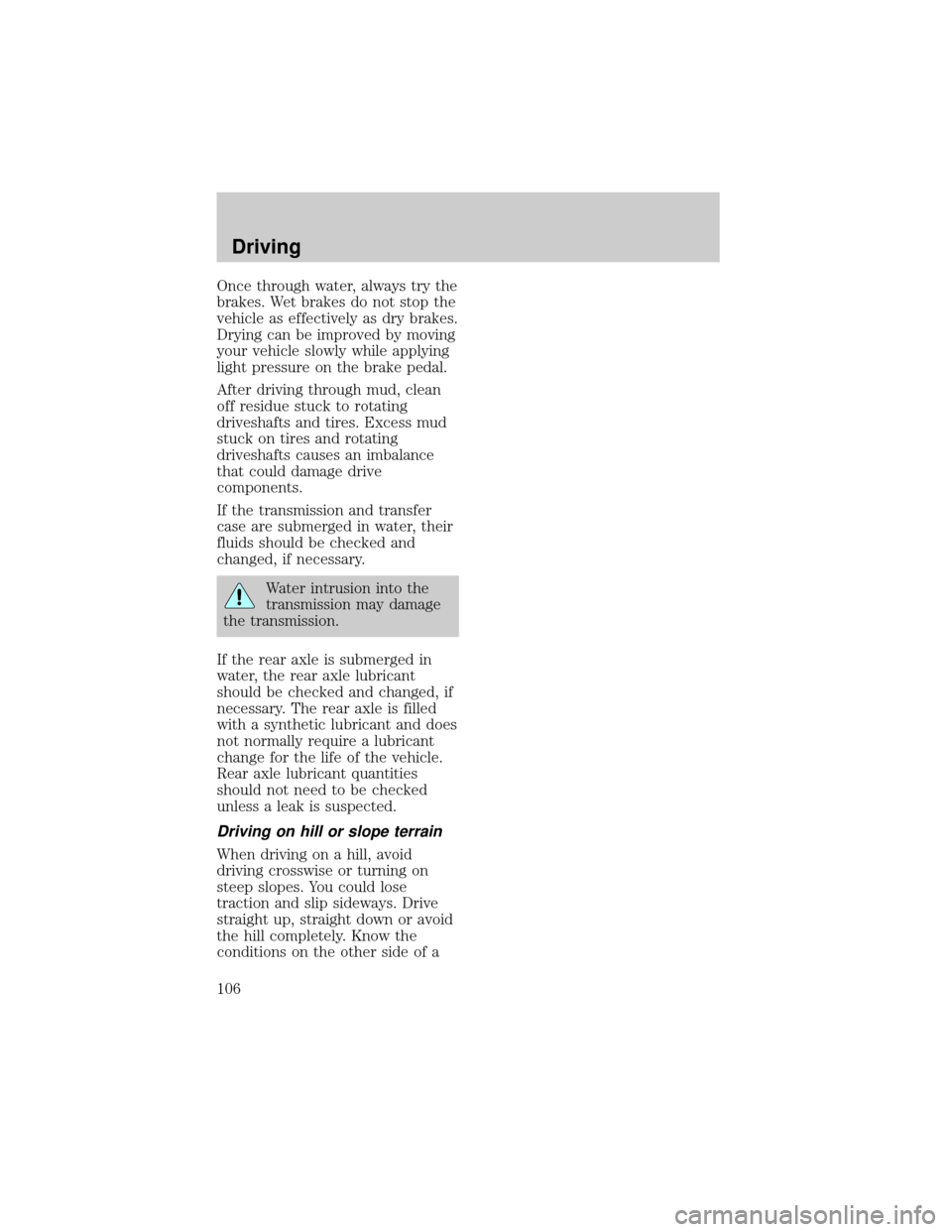Page 91 of 219

control switch on the end of the
gearshift lever.
The transmission control indicator
light (TCIL) (the word OFF) on
the end of the gearshift lever will
illuminate.
Drive± Not shown on the display.
Activate by pressing the
transmission control switch on the
end of the gearshift lever with the
gearshift in the
position. The
TCIL (the word OFF) will
illuminate on the gearshift lever.
Transmission operates in gears one
through three.
(Drive) provides
more engine braking than
(Overdrive) and is useful when:
²driving with a heavy load
²towing a trailer up or down
steep hills
²additional engine downhill
braking is desired. If towing a
trailer, refer toDriving while
you towin theTowing a trailer
chapter.
To return to
(Overdrive) mode,
press the transmission control
switch. The TCIL (the word OFF)
will no longer be illuminated.
Each time the vehicle is started,
the transmission will automatically
return to normal overdrive mode.
Every time the vehicle is shut off
and restarted, you must press the
transmission control switch to
cancel overdrive operation if
driving in overdrive is not desired.
OVERDRIVE
Driving
91
Page 92 of 219
2 (Second)
Use 2 (Second) to start-up on
slippery roads or to provide
additional engine braking on
downgrades.
1 (First)
Use 1 (Low) to provide maximum
engine braking on steep
downgrades. Upshifts can be made
by shifting to 2 (Second) or to
(Overdrive). Selecting 1 (Low)
at higher speeds causes the
transmission to shift to a lower
gear, and will shift to 1 (Low) after
vehicle decelerates to the proper
speed.
MANUAL TRANSMISSION
OPERATION (IF EQUIPPED)
Using the clutch
Vehicles equipped with a manual
transmission have a starter
interlock that prevents cranking
the engine unless the clutch pedal
is fully depressed.
When starting a vehicle with a
manual transmission, you must:
Driving
92
Page 97 of 219
4. Turn ignition to Off.
Do not park your vehicle
in Neutral, it may move
unexpectedly and injure
someone. Use 1 (First) gear and
set the parking brake fully.
Reverse
Make sure that your vehicle is at a
complete stop before you shift into
R (Reverse). Failure to do so may
damage the transmission.
Put the gearshift in N (Neutral)
and wait at least three seconds
before shifting into R (Reverse).
You can shift into R (Reverse) only
by moving the gearshift from left
of 3 (Third) and 4 (Fourth) gears
before you shift into R (Reverse).
This is a special lockout feature
that protects you from accidentally
shifting into R (Reverse) when you
downshift from
D(Overdrive).
3
2
1
5
4
13
24RD
Driving
97
Page 101 of 219
2. Place the gearshift lever in N
(Neutral) (automatic transmission)
or depress the clutch (manual
transmission).
3. Pull the transfer case shift lever
through N (Neutral) directly to 4H
(4WD High) or 4L (4WD Low).
Shifting from N (Neutral) to 4H
(4WD High) or 4L (4WD Low)
With the transfer case in N
(Neutral) the vehicle is free to
move with either the automatic
transmission in P (Park) or with
the manual transmission in any
gear.
1. Stop the vehicle.
2. Depress the brake.
3. Place the gearshift in N
(Neutral) (automatic transmission)
or depress the clutch (manual
transmission).
4. Place the transfer case lever in
the desired gear.
Using the N (Neutral) position
The transfer case neutral
position overrides the
2H
4H
4L N
2H
4H
4L N
Driving
101
Page 102 of 219
transmission and puts the
vehicle in neutral regardless of
transmission gearshift lever
position. The vehicle can move
forward or backwards. Make
sure the parking brake is
applied and the vehicle is never
left unattended with the
transfer case in neutral.
This position should only be used
when towing the vehicle. Refer to
Wrecker towingin theRoadside
emergencieschapter.
Do not leave the vehicle
unattended with the
transfer case in the N (Neutral)
position. Always set the parking
brake fully and turn off the
ignition when leaving the vehicle.
Using the electronic shift 4WD
system (if equipped)
Positions of the electronic shift
system
2H (2WD High)± Power to rear
axle only.
4H (4WD High)± Power
delivered to front and rear axles
for increased traction.
4L (4WD Low)± Power to front
and rear axles at low speeds.
2H
4H
4L N
Driving
102
Page 103 of 219
Shifting from 2H (2WD high) to
4H (4WD High)
Move the 4WD control to the 4H at
a stop or up to 88 km/h (55 mph).
At temperatures below 0ÉC (32ÉF),
shifts from 2H to 4H should not be
performed above 72 km/h (45
mph).
²Do not shift into 4H with the
rear wheels slipping.
Shifting from 4H (4WD high) to
2H (2WD high)
Move the 4WD control to 2H at
any forward speed.
Shifting between 4H (4WD high)
and 4L (4WD low)
1. Bring the vehicle to a stop.
2. Depress the brake.
3. Place the gearshift in N
(Neutral) (automatic transmission)
or depress the clutch (manual
transmission).
4H
2H
4L
4H
2H
4L
Driving
103
Page 105 of 219

If your vehicle gets stuck
If the vehicle is stuck, shift the
transmission in a steady motion
between forward and reverse
gears. Allow the transmission to
engage, then press lightly on the
accelerator.
DO NOT rock the vehicle
for more than a few
minutes. The transmission and
tires may be damaged or the
engine can overheat.
Do not spin the wheels at
over 35 mph (55 km/h).
The tires may fail and injure a
passenger or bystander.
Sand
When driving over sand, try to
keep all four wheels on the most
solid area of the trail. Do not
reduce the tire pressures but shift
to a lower gear and drive steadily
through the terrain. Apply the
accelerator slowly and avoid
spinning the wheels.
Mud and water
If you must drive through high
water, drive slowly. Traction or
brake capability may be limited.
When driving through water,
determine the depth; avoid water
higher than the bottom of the hubs
(if possible) and proceed slowly. If
the ignition system gets wet, the
vehicle may stall.
Driving
105
Page 106 of 219

Once through water, always try the
brakes. Wet brakes do not stop the
vehicle as effectively as dry brakes.
Drying can be improved by moving
your vehicle slowly while applying
light pressure on the brake pedal.
After driving through mud, clean
off residue stuck to rotating
driveshafts and tires. Excess mud
stuck on tires and rotating
driveshafts causes an imbalance
that could damage drive
components.
If the transmission and transfer
case are submerged in water, their
fluids should be checked and
changed, if necessary.
Water intrusion into the
transmission may damage
the transmission.
If the rear axle is submerged in
water, the rear axle lubricant
should be checked and changed, if
necessary. The rear axle is filled
with a synthetic lubricant and does
not normally require a lubricant
change for the life of the vehicle.
Rear axle lubricant quantities
should not need to be checked
unless a leak is suspected.
Driving on hill or slope terrain
When driving on a hill, avoid
driving crosswise or turning on
steep slopes. You could lose
traction and slip sideways. Drive
straight up, straight down or avoid
the hill completely. Know the
conditions on the other side of a
Driving
106